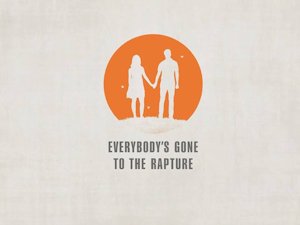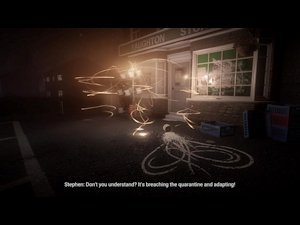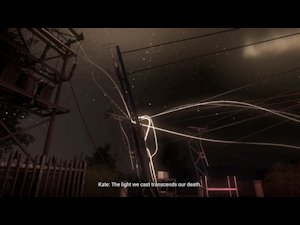Everybody's Gone to the Rapture: Is It Art?
 | | Spoiler alert: everybody has gone to the rapture |
*WARNING: This article contains major spoilers.*
Free this month on Playstation Plus is an interesting little 2015 game called Everybody's Gone to the Rapture. Created by small developers The Chinese Room (with the help of Sony Computer Entertainment's Santa Monica Studios), Everybody's Gone to the Rapture takes advantage of a growing niche of games that are sometimes referred to as "walking simulators," deliberately slow-paced first-person adventure games that have minimal interactivity and focus primarily on audio-visual style and narrative. Other notable walking simulators include the aborted Silent Hills demo P.T., the socially aware Gone Home, and the sensational Firewatch.
Everybody's Gone to the Rapture, like all these games, is not designed to please all audiences. You, the player, walk at a snail's pace through empty, relatively silent streets and buildings in a small English village that has apparently fallen victim to an enigmatic mass exodus. You can listen to brief recordings through the occasional radio or telephone, open doors, flip on and off lights, and witness ghostly echoes of past events, but not much else. There's no guns to weild, no enemies to fight, no puzzles to solve, and no branching storylines to choose. You can't even run.
 | | Shropshire's a beautiful, pastoral, idyllic little place |
So before we can address the question of whether or not it qualifies as art, we have to tackle the question of whether or not it's even a traditional video game. It certainly feels more cinematic than your average game, as the aforementioned focus on audio-visual style and narrative are precisely the hallmarks of traditional cinema. It has a fully realized setting; it is lovingly scored; and it tells a singular, distinct story, albeit completely out of sequence. Much of the experience is optional--you can make a beeline to the final chapter from the start and skip over practically everything else--but nothing about how you interact with the world changes it. It is interactive in the barest sense of the term, but since you do have a modicum of control over the order of events (and the camera), it qualifies more as a video game than as film, even though it is a relatively passive experience.
Does it express anything? I think so. The game has a lonely, isolated feel, and as the plot delicately unravels, there is added thematic poignancy and emotional weight to it. This separates it from a simple tech demo, as it truly seems like creative expression is its primary motive. Everybody's Gone to the Rapture certainly can't be clumped together with soulless commercial enterprises that exist solely to entertain and make money (not that there's anything wrong with simple entertainment--it just doesn't always qualify as "art").
 | | The Pattern is everywhere |
So let's look at the plot. You come to learn over the course of your walk through town that some kind of "Pattern" was discovered in the night sky by scientists Kate Collins and Stephen Appleton. After being burned while studying it, Stephen and Kate discover that the Pattern takes the form of ethereal light and appears to infect people with a disease that progresses quickly from nosebleeds to brain hemmoraging and ends in a person's inexplicable blinking out of existence, leaving only the faintest hint of ash behind. While Kate stays behind to study the phenomenon, Stephen races around town trying to contain it, discovering that it can travel through phone lines and leaves weird traces of itself in unexpected places, like in the randomness of falling paint. He eventually concludes that the entire village must be gassed to prevent the spread of the Pattern to the outside world, and he successfully convinces the local government to do just that, killing everybody. Meanwhile, Kate comes to believe that the Pattern is something that transcends life and time, and in the end, she is found communing with it for all eternity.
This main plot is difficult to understand, much less crack, but it is helped along by a series of subplots that elucidate the subtle meaning behind what the Pattern is and what exactly happened to the village. They don't seem relevant at first, but you are given glimpses into the personal lives of several townsfolk--be it the weak drunk who couldn't watch his wife die of a terminal illness, the priest who may or may not have ended her suffering with a dose of morphine, the woman having an affair with Stephen, the mother whose racism gets between her son and his wife, or the young lovers who plot an elaborate escape even before the Pattern arrives--and those glimpses shape a real understanding of what the town was like at the time of the titular rapture.
 | | The light we cast transcends our death |
Kate tries to explain in her recordings that the Pattern and these personal stories are deeply connected with one another, that light itself is merely the expression of a moment in time--the transmission of life and love across the universe--and that it has brought all these people together into one harmonious infinity like a rising tide collecting isolated pieces of driftwood from a beach. Through this understanding, she comes to empathize with everyone, forgive every sin, and embrace the light, even as it appears to take over the entire world. Thus, there is a duality between Stephen and Kate, in that Stephen races around and does everything he can to forestall the inevitable, while Kate comprehends it as something beautiful.
Put in simple terms: this is a story about overcoming regret, coping with death, and the inherent value of human compassion, told in a unique and intriguing way. That, in and of itself, qualifies it as art in my book, but added to the beautiful visuals and arresting musical score, I have a hard time seeing any argument against it being art.
As I said, it is certainly not a game for everyone, and there will be those who doubt it can be rightly called a "game." However, it is just as certainly artistic in what it's trying to convey. For those patient enough to experience it, Everybody's Gone to the Rapture can be a deeply emotional journey that goes beyond a simple sci-fi/fantasy thought experiment and teaches you something about life itself. So yeah, it's art. Case closed.
-e. magill 11/17/2016
|
|